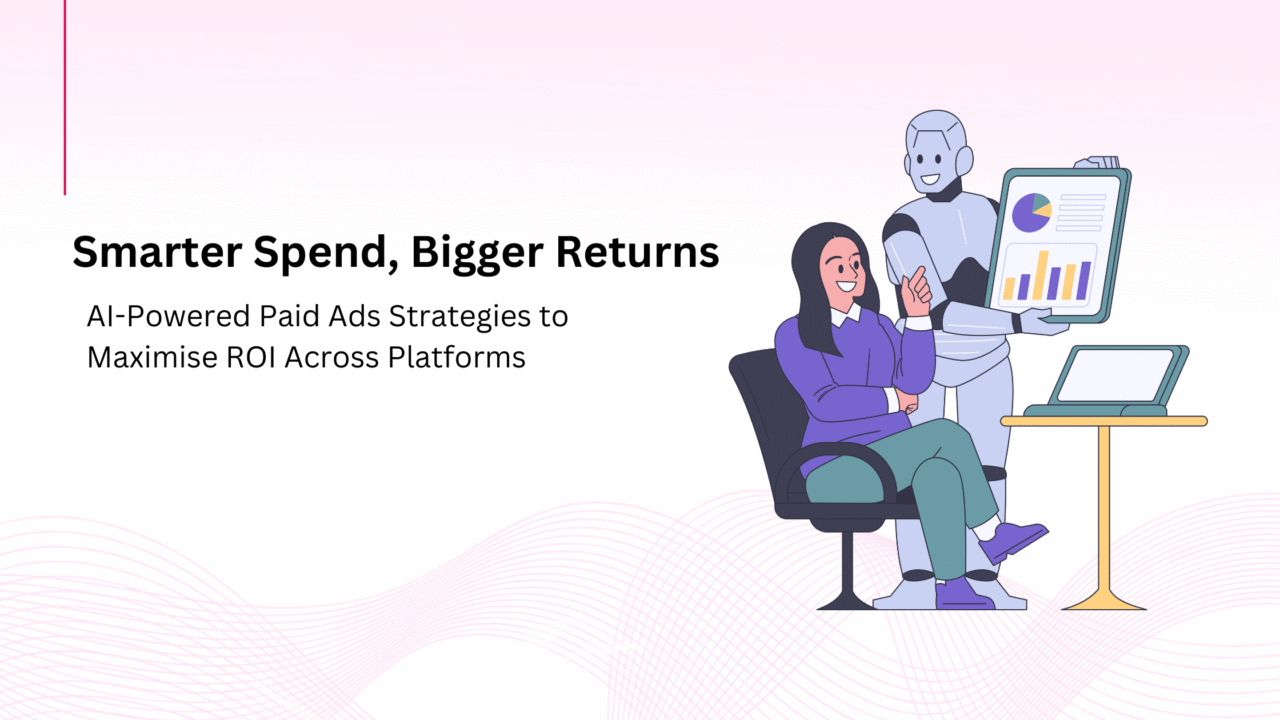In a competitive digital landscape, startups and SMEs must squeeze maximum value out of every ad dollar. To boost ROI in paid ads on Google, Meta (Facebook, Instagram), and LinkedIn, efficiency is now non-negotiable. Rising CPCs, audience saturation, and tougher competition make it essential to maximise returns from every campaign. AI intelligence is no longer optional; it has become the lever that shifts campaigns from average performance to high-return outcomes.
In 2025, advertisers using AI-driven tools have seen notable lifts in conversion rates, better audience targeting, and more efficient spend. This blog shows how you can use AI to improve paid ads ROI across Google, Meta & LinkedIn — with actionable strategies and trending best practices.
1. Smarter & Automated Budget Allocation to Boost ROI in Paid Ads
CPC inflation may be slowing in some markets, but costs are still high. Smart allocation ensures you don’t overspend in low-performance segments. AI helps shift spend to what works in real time — channels, audiences, and creatives.
Key AI-Driven Budget Strategies
| Strategy | What It Does | Benefit for SMEs / Startups |
|---|---|---|
| Smart Bidding (Target CPA, Target ROAS, Maximize Conversions) | Machine learning adjusts bids in real time based on signals like device, location, or behaviour. | More conversions for the same spend; less waste. |
| AI Campaign Types (Performance Max, Demand Gen, etc.) | Simplifies campaign setup while expanding cross-channel reach. | Faster scaling with less manual work. |
| Predictive Forecasting & Budget Simulations | Uses past performance and trends to simulate spend vs. return. | Helps avoid surprises; supports seasonal planning. |
Best practices:
-
Begin with a modest test budget so AI can gather learning data.
-
Track CPA, ROAS, Conversion Rate rather than clicks.
-
Reallocate budgets dynamically across platforms.
For this to work effectively, a strong foundation in data science and analytics is essential.
2. Precision Audience Targeting & Lookalike Audiences to Boost ROI
AI relies on richer behavioural signals, purchase intent, and engagement patterns instead of demographics alone. This allows advertisers to build lookalike audiences that mirror high-value customers and expand reach without diluting quality.
| Platform | Best Use-Cases | How AI Helps |
|---|---|---|
| Google Ads | High-intent searches, discovery campaigns | Suggests new queries, blocks irrelevant ones |
| Meta | Social engagement, dynamic ads | Expands audiences, optimises placements |
| B2B lead generation | Enhances firmographic filters, retargeting |
AI-driven audience building must balance automation with originality. The debate on whether machines can truly replace humans in marketing creativity is still relevant here.
3. Creative Testing & Dynamic Optimisation for Higher ROI
Even with the best targeting, poor creatives stall performance. AI solves this by testing multiple creative variations quickly and predicting winners.
-
Dynamic Creative Optimisation (DCO): Swaps elements like images and CTAs based on user context.
-
A/B/n testing: Runs multiple variations simultaneously.
-
Creative scoring: Predicts likely engagement before rollout.
Refreshing ads regularly helps avoid fatigue, especially on Meta and Instagram, and many brands are now turning to generative AI for business creativity tools like ChatGPT and DALL·E to streamline asset production.
4. Real-Time Insights & Predictive Analytics
AI offers more than dashboards — it predicts which campaigns or leads will convert and identifies waste before it grows.
Key trends include:
-
Negative keyword discovery to stop irrelevant clicks.
-
Attribution models that show which channel really drove a conversion.
-
Predictive modelling to rank leads by probability of closing.
This aligns with the rise of adaptive AI, which continuously improves based on feedback loops.
5. Case Studies & Benchmarks
-
Google’s AI-driven ad formats have delivered double-digit conversion lifts without increasing CPA.
-
LinkedIn has become a stronger channel for B2B as AI sharpens targeting.
-
Meta is investing heavily in fully automated ad generation — upload assets and budget, and the system creates optimised campaigns.
6. Risks & Mitigation
| Risk | Mitigation |
|---|---|
| Over-automation weakens brand voice | Maintain human oversight on messaging |
| Dependence on single platform | Diversify spend across Google, Meta, LinkedIn |
| Low-intent traffic inflates cost | Use negative keywords and exclude poor segments |
| Data privacy concerns | Use first-party data ethically; ensure compliance |
7. Actionable Checklist
-
Audit campaigns for wasted spend.
-
Build lookalike seeds from past high-value customers.
-
Test one AI campaign type like Performance Max.
-
Refresh creatives frequently.
-
Set clear KPIs (CPA, ROAS, CLTV).
-
Monitor weekly; adjust budgets and creatives based on data.
Conclusion
AI is reshaping paid advertising by making it smarter, faster, and more efficient. For startups and SMEs, the impact is clear: boost ROI in paid ads with better targeting, dynamic budgets, fresher creatives, and predictive insights. To integrate this into a wider roadmap and increase ROI in advertising across all functions, consider how your AI strategy aligns marketing with broader business growth.

